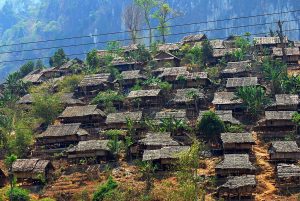The effects of Myanmar’s escalating political crisis are beginning to be felt in neighboring countries, with reports emerging from both Thailand and India of people fleeing across borders in search of sanctuary.
On March 12, Indian media reported that the country’s Ministry of Home Affairs (MHA) had written to the Chief Secretaries of the states of Nagaland, Manipur, Mizoram, and Arunachal Pradesh, in the country’s hilly east, to “take appropriate action as per law to check illegal influx from Myanmar into India.”
This comes amid reports that groups of Myanmar nationals, apparently numbering more than 400 in total, have crossed the border to escape the deteriorating situation inside the country. The letter stated that the “illegal influx from Myanmar has started” and called on the state governments and the Assam Rifles, a paramilitary force under the authority of India’s MHA, to “stay alert and take appropriate action to prevent a possible influx into Indian territory.”
Among those who have crossed the border are an unverified number of Myanmar policemen, who claim they fled after refusing orders to fire on unarmed protesters. “We don’t have the guts to shoot at our own people who are peaceful demonstrators,” one group of four policemen said in a statement given to authorities in Mizoram. Another defecting policeman who spoke to the Reuters news agency said he refused to carry out orders to “shoot till they are dead,” referring to anti-coup protesters who have been the subject of increasingly violent crackdowns.
The protests against the Myanmar junta, which ousted the National League for Democracy government and seized power on February 1, show no sign of slowing down. At least 224 people have been confirmed killed in anti-coup protests since early February, in addition to 2,258 who have been arrested, charged or sentenced in relation to the resistance to military rule, according to the Assistance Association for Political Prisoners.
As the military’s attempted suppression of the protests has turned increasingly violent, the chaos could also be about to spill over the country’s eastern border into Thailand. Yesterday, Reuters reported that hundreds of people have fled Myanmar’s towns and cities for areas controlled by ethnic militias along the Thai border, prompting Thai authorities to prepare for an influx of refugees into its western provinces.
Citing an official from the Karen National Union (KNU), the report claims that almost a thousand people were sheltering inside KNU-controlled territory. Amid the turmoil in Myanmar, Thai authorities set aside areas to shelter more than 43,000 people in Mae Sot district, which borders Myanmar’s Kayin State.
For decades, refugee camps have lined Thailand’s borders with Kayin and Kayah states, to house tens of thousands of people who have fled long-running civil wars inside Myanmar since the 1980s.
While Thailand has attracted ire for its seemingly accommodating position toward the military’s coup (a move that the country’s Prime Minister Prayut Chan-o-cha was instrumental in pulling in 2014), the one thing that could get Bangkok to become more active in attempts to resolve its neighbor’s crisis is the possibility of refugees fleeing into Thailand in large numbers.
As Joshua Kurlantzick of the Council on Foreign Relations noted in an article yesterday, crackdowns on mass protests in 1988 and 2007, as well as the ethnic cleansing of Rohingya Muslims in Rakhine State after 2016, have all prompted Myanmar nationals to flee overland into Bangladesh, India, and Thailand, as well as by sea to Indonesia and Malaysia. Civil conflicts in the borderlands have also forced people to cross the border into China.
It can thus be expected that as long as the crisis continues, neighboring countries will increasingly feel its effects, and that Myanmar’s national crisis will increasingly translate into a regional one.

































